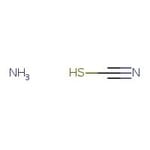Search Thermo Fisher Scientific
Thermo Scientific Chemicals
Ammonium thiocyanate, 98+%, Thermo Scientific Chemicals
Catalog number: A10632.0I
5000 g, Each



Thermo Scientific Chemicals
Ammonium thiocyanate, 98+%, Thermo Scientific Chemicals
Catalog number: A10632.0I
5000 g, Each
Quantity
Catalog number: A10632.0I
also known as A10632-0I
Price (USD)
Price: 543.00
Your price:
Quantity
-
Chemical Identifiers
CAS
1762-95-4
IUPAC Name
ammonium cyanosulfanide
Molecular Formula
CH4N2S
InChI Key
SOIFLUNRINLCBN-UHFFFAOYSA-N
SMILES
[NH4+].[S-]C#N
Specifications
Assay (Argentometric Titration)
≥98.0 to ≤102.0%
Identification (FTIR)
Conforms
Water Content (Karl Fischer Titration)
≤1.25%
Appearance (Color)
White to pale cream
Form
Crystals or crystalline powder
Description
Ammonium thiocyanate has many uses in manufacturing chemicals such as metal thiocyanates [CuSCN, Ca(SCN)2, NaSCN, KSCN] and in a number of pharmaceuticals. It is used in freezing solutions, pickling, printing, and as a corrosion inhibitor against acid gases. It is used in the photography industry as a stabilizer or an accelerator. It is also used in fertilizers, fabric dyeing, zinc coating, electroplating and as a separator of zirconium and hafnium as well as gold and iron. It is also used in analytical chemistry for titrimetric analysis and to determine the iron content by colorimetry in soft drinks.
This Thermo Scientific Chemicals brand product was originally part of the Alfa Aesar product portfolio. Some documentation and label information may refer to the legacy brand. The original Alfa Aesar product / item code or SKU reference has not changed as a part of the brand transition to Thermo Scientific Chemicals.
Applications
Ammonium thiocyanate has many uses in manufacturing chemicals such as metal thiocyanates [CuSCN, Ca(SCN)2, NaSCN, KSCN] and in a number of pharmaceuticals. It is used in freezing solutions, pickling, printing, and as a corrosion inhibitor against acid gases. It is used in the photography industry as a stabilizer or an accelerator. It is also used in fertilizers, fabric dyeing, zinc coating, electroplating and as a separator of zirconium and hafnium as well as gold and iron. It is also used in analytical chemistry for titrimetric analysis and to determine the iron content by colorimetry in soft drinks.
Solubility
Soluble in water, ethanol, methanol, ammonia and acetone. Insoluble in chloroform and ethyl acetate.
Notes
Light sensitive and hygroscopic. Incompatible with strong oxidizing agents, strong acids and lead nitrate.
Ammonium thiocyanate has many uses in manufacturing chemicals such as metal thiocyanates [CuSCN, Ca(SCN)2, NaSCN, KSCN] and in a number of pharmaceuticals. It is used in freezing solutions, pickling, printing, and as a corrosion inhibitor against acid gases. It is used in the photography industry as a stabilizer or an accelerator. It is also used in fertilizers, fabric dyeing, zinc coating, electroplating and as a separator of zirconium and hafnium as well as gold and iron. It is also used in analytical chemistry for titrimetric analysis and to determine the iron content by colorimetry in soft drinks.
Solubility
Soluble in water, ethanol, methanol, ammonia and acetone. Insoluble in chloroform and ethyl acetate.
Notes
Light sensitive and hygroscopic. Incompatible with strong oxidizing agents, strong acids and lead nitrate.
RUO – Research Use Only
Figures
Documents & Downloads
Certificates
Search by lot number or partial lot number
Frequently asked questions (FAQs)
Citations & References
Search citations by name, author, journal title or abstract text